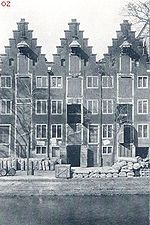- Noordsche Compagnie
-
The Noordsche or Groenlandse Compagnie (Noordse Compagnie or Compagnie van Spitsbergen) (English: Northern or Greenland Company) was a cartel for whaling, founded by several cities in the Netherlands. The company existed from 1614 to 1642, but soon after its founding became entangled in conflicts with England, Denmark, France, and within the Netherlands.
Contents
History
In 1598 a whale beached at Wijk aan Zee. The animal was sold for 126 guilders and the jaw was given to Jan van Nassau as a gift, and transported to Dillenburg.[1]
In 1612 the first mention is made of a commercial expedition to Novaya Zemlya, after it was concluded that whaling at the Cape of Good Hope, in the southern Atlantic, offered little prospects of profit. Willem Cornelisz. van Muyden was one of the first skippers to set sail to the North. In 1613 he was the admiral of two ships that were sent to Spitsbergen: the Fortuyn and the Neptunus. On board were twelve or thirteen French Basques.[2] The remaining crew (48 men) came from North-Holland.
The next year, on 27 January 1614, the Noordsche Compagnie was founded, initially for a period of two years. Supposedly on Vlieland.[citation needed] In 1617 the charter was renewed for four years, and in 1622 for another twelve years.
Whaling was done in the summer months. Ships and crew left the diverse ports of the Dutch Republic in May or June. After a three week journey they arrived at the coastal waters of Spitsbergen, Jan Mayen- or Bear Island. In August, September, or October the ships returned to the Republic. Soon whaling stations were established on Jan Mayen and Spitsbergen, the best known of these being Smeerenburg. These stations saved much space in the cargohold of the ships, and also held relieve the stench. For years the Noordsche Compagnie controlled the monopoly for whale oil. For every expedition, participants would invest capital. When the expedition had returned, the profit would immediately be divided amongst the investors.
Organization
 The Greenland warehouses on the Keizersgracht 40-44. Built in 1621. Photo from 1924, two years after the renovation. Originally there were five, of which only these three remain[3]
The Greenland warehouses on the Keizersgracht 40-44. Built in 1621. Photo from 1924, two years after the renovation. Originally there were five, of which only these three remain[3]
The administration of the Noordsche Compagnie was divided into five chambers. These were relatively independent and located in Amsterdam, Hoorn, Enkhuizen, Rotterdam, and Delft. Each city had its own installations on the polar islands. In 1616 the Zeelandic Lampsin family took part in the company. From then on Vlissingen, Middelburg and Veere also had a chamber. In 1634 the charter was renewed for another eight years. In 1636 two Frisian chambers were created: Harlingen and Stavoren.
Trading territories
The trading area of the Noordsche Compagnie stretched from the Davis Strait to Novaya Zemlya, north of Russia. The company did not make any claims to the territory, they were only concerned with their trading-monopoly.
Initially the company made much use of Basque Harpooners and navigators. Aside from whales, walrus and seals were also hunted. The polar bear hunt resulted in skins and fur. Whale baleen was used to make picture frames for paintings, walking sticks and knifehilts.
Michiel de Ruyter, the most famous Dutch admiral, served as pilot on a ship of the Noordsche Compagnie from 1633 to 1635. He was probably familiar with the route from the time that he was still a sailor.
The company was dissolved in 1642. The company had started receiving intense competition from Dutch interlopers and Danish whalers. Whaling was privatized, and taken over by the private sector.
The participation of the population of the West Frisian Islands to whaling is evident from the tombstones of the ship-captains buried there, which were made from whale jawbones.
References
- ^ Landwehr, J. (1981) De Nederlander uit en thuis. Spiegel van het dagelijkse leven uit bijzondere zeventiende-eeuwse boeken, p. 102-103. (Dutch)
- ^ Hart, S. (1957) De eerste Nederlandse tocht ter walvisvaart. In: Jaarboek Amstelodamum, p. 40.
- ^ Groenlandse pakhuizen, Bureau Monuments and Archeology, Amsterdam
External links
- Over Pieter Jacobsz. Geusebroeck (Dutch)
- Missie Jan Mayen (Dutch)
- DE KLEINE VISSERIJ (Dutch)
- Traankokerijen op het Jan Mayeneiland (Dutch)
- Mr. S. Muller Fz. (1874), Geschiedenis der Noordsche Compagnie, Gebr. van der Post, Utrecht (Dutch)
Bibliography
- Hart, S. (1957) De eerste Nederlandse tocht ter walvisvaart. In: Jaarboek Amstelodamum, p. 27-64. (Dutch)
- Dillen, J.G. van (1970) Van Rijkdom en Regenten. Handboek tot de Economische en Sociale Geschiedenis van Nederland tijdens de Republiek, p. 248-55. (Dutch)
Categories:- 1614 establishments
- 1642 disestablishments
- Chartered companies
- Whaling
- Whaling in the Netherlands
Wikimedia Foundation. 2010.


